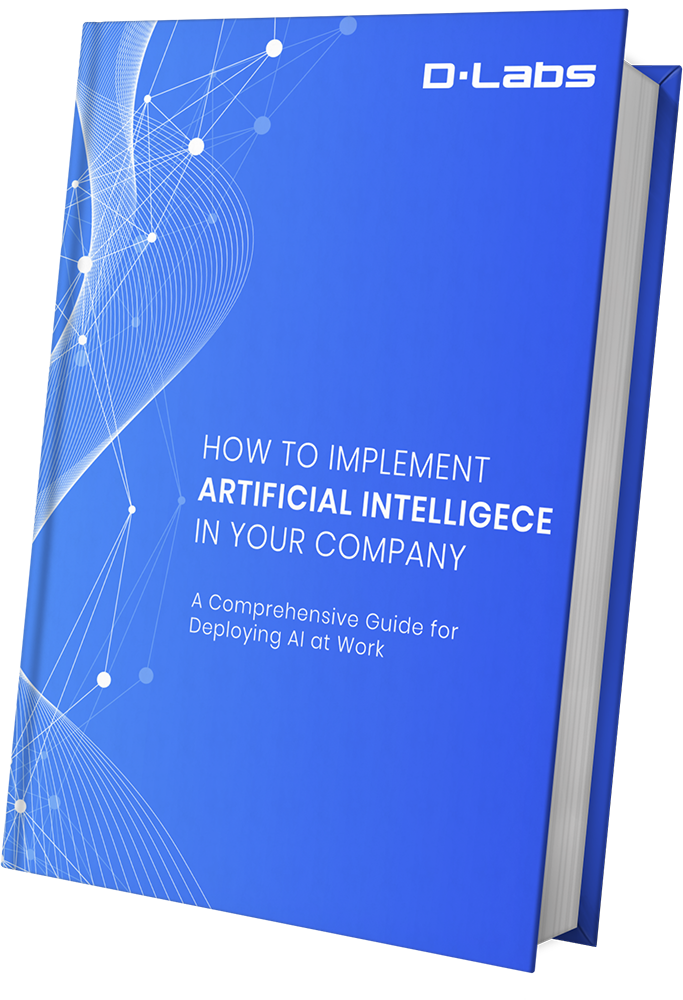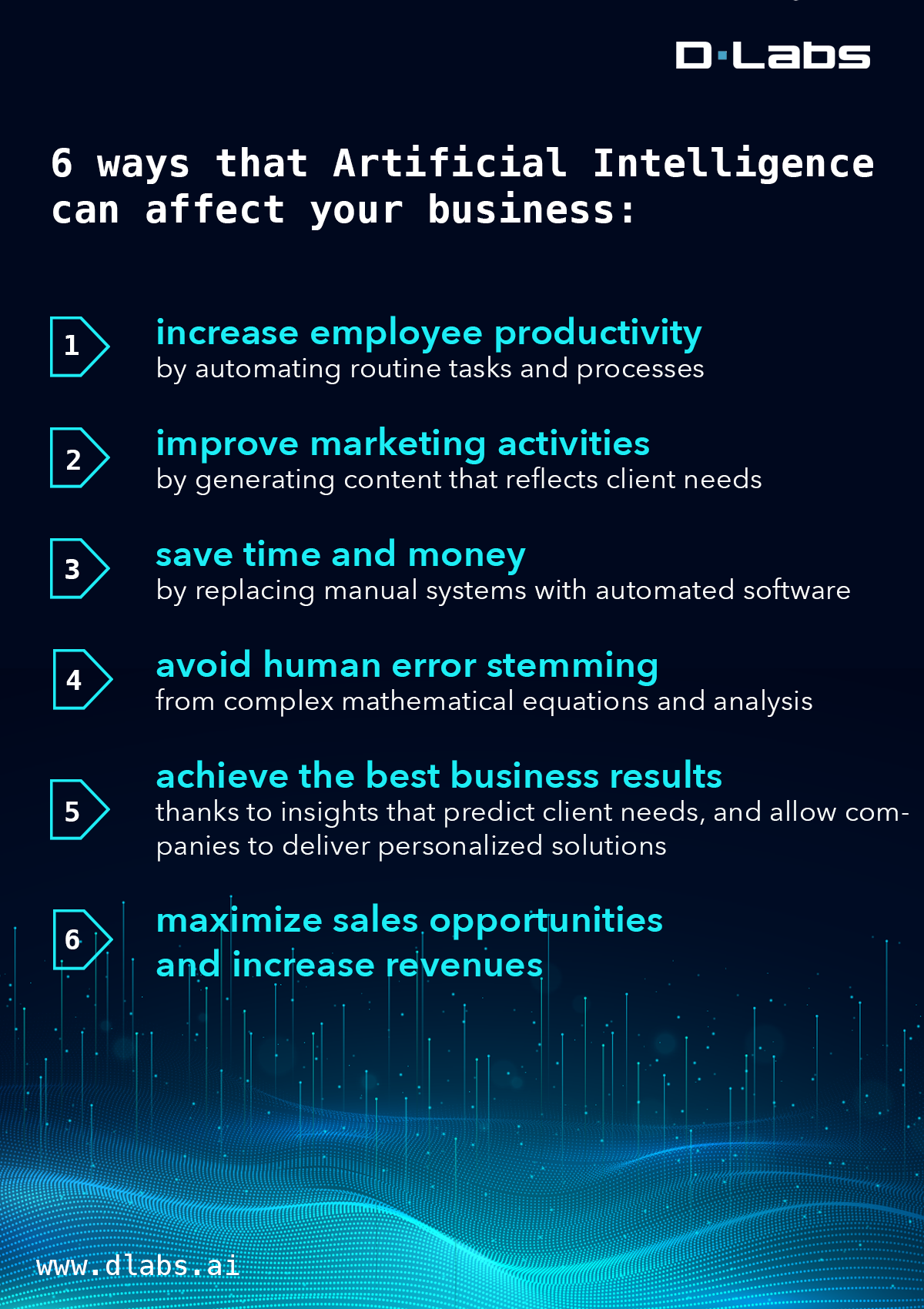Artificial Intelligence is playing an ever more important role in business. Every year, we see a fresh batch of executives implement AI-based solutions across both products and processes. But do you know how they do it? And if you were to try the same, would you know how to achieve the best results? By the end of this article, you will — you’ll see precisely how you can use AI to benefit your entire operation.
The data proves AI has a role in business
As is crucial with everything AI, let’s start by grounding ourselves in data. According to PwC’s report, Bot.Me: A revolutionary partnership, 67% of executives believe AI will help people and machines work together to improve operations — by combining artificial and human intelligence.
Moreover, PwC’s analysis suggests global GDP will increase by up to 14% by 2030 thanks to the ‘accelerating development and adoption of AI’ — that means a $15.7 trillion boost to the economy. But what are the driving forces of such growth?
On the one hand, an increase in business productivity. On the other, an increase in consumer demand, driven by better quality and increasingly personalized AI-enhanced products.
It’s hard to deny, AI is the future of business — and sooner or later, the majority of companies will have to implement it to stay competitive.
Seven key steps to implementing AI in your business
Step 1: Understand the difference between AI and ML
If you think you want to use AI, but you’re not sure where to start, start here: by learning the difference between artificial intelligence and machine learning. The two terms are often used interchangeably, but they have subtly different applications.
Only once you understand this difference can you know which technology to use — so, we’ve given you a little head start below.
- Artificial Intelligence (AI): AI refers to the ability of programmed machines (computers or robots) to “think” like people and imitate human behavior. It is often used to describe systems endowed with intellectual processes, such as self-studying and problem-solving. Systems based on AI can assimilate, analyze, and use actual facts and knowledge to obtain further information. For example, speech, voice, and image recognition all use artificial intelligence.
- Machine Learning (ML): A 1959 definition coined by Arthur Samuel says, ‘machine learning is a field of study that gives computers the ability to learn without being explicitly programmed’ — and if that sounds like AI, that’s because it is. ML is a field of AI that builds on the idea that systems can learn from data, then make decisions in the absence of human participation.
Want more detail? Check our article on the key differences between AI, Data Science, Machine Learning, and Big Data.
Ok… so now you know the difference between artificial intelligence and machine learning — it’s time to answer two related questions before we dive into actual implementation.
How can AI improve business effectiveness?
In truth, the answer depends on your precise needs and expectations. But we’ve summarized the main advantages in the infographic below.
Where is AI ineffective?
While AI has many strengths, it does fall short in certain circumstances. And if you want to avoid any misplaced investments, you must recognize what AI cannot — or should not — do.
- Code software: Despite what Hollywood says, machines can’t program themselves. In Fred Brooks’ work, “The Mythical Man-Month” he explains that coding software involves understanding the ‘fundamental complexities of the real world’ — AI cannot do that because AI cannot understand our reality;
- Generate creative content: Yes, AI can create content using data. However, it cannot be creative (by which we mean write imaginative prose without guidelines);
- Make ethical decisions: Machines don’t have feelings. They lack a conscience. So, we can’t let them make moral judgments for people (an interesting consideration in the development of self-driving technology!).
- Come to a final decision independently: While AI can help us, it cannot replace us. But what do we mean by that? We cannot dotingly trust AI to make decisions on our behalf. We must appreciate the fact that AI is still prone to making mistakes.
- Innovate and invent: AI can learn from data, but it has a limited ability to draw conclusions based on a given action. And it cannot be creative, nor come up with new solutions or ideas.
“Artificial Intelligence is like an artificial plant. It gives many of the same benefits but it’s not the real thing.”
— James Tagg, tech entrepreneur and author of ‘Are The Androids Dreaming Yet?’
Step 2: Define your business needs
Now you know the difference between Artificial Intelligence and Machine Learning, it’s time to consider what you’re looking to achieve, alongside how these two technologies can help you with that.
First of all, define the problems you want AI to solve — to do this, try to answer these five questions:
- What outcome(s) do you want to see?
- What are the main obstacles to achieving these outcomes?
- How can AI help your business move towards success?
- How will you measure success?
- What data do you have today, and what additional data do you need?
The answers to these questions will help you to define your business needs, then step towards the best solution for your company.
Step 3: Prioritize the main driver(s) of value
Once you’ve defined your business needs, you need to identify the potential business and financial benefits of your AI project. You should consider all the possible AI implementations and try to connect each initiative with concrete returns: do this by focusing on near-term goals and illustrate either the financial or business value as best you can.
As you explore your objectives, don’t lose sight of value drivers (like increased value for your customers or improved employee productivity), as much as better business results. And consider if machines in place of people could better handle specific time-consuming tasks.
A word of warning: do not implement solutions purely based on a fad. What is popular today may not be popular tomorrow.
Rather, consider if you can effectively integrate a solution into your daily workflow, analyze how it fits into your business processes, and explore whether adding an AI-based solution to your existing products or services would boost your operation over the long-term.
Step 4: Evaluate your internal capabilities
There’s often a chasm between what you want to develop and what you can actually achieve within a given time frame. Therefore, after prioritizing your objectives, it’s time to decide what approach works best for you — be it:
- Building a new solution from scratch using internal resources
- Buying a ready-made product off the shelf
- Collaborating with a partner to develop your AI project
- Outsourcing the entire AI development process
Whichever approach seems best, it’s always worth researching existing solutions before taking the plunge with development. If you find a product that serves your needs, then the most cost-effective approach is likely a direct integration.
Step 5: Consider consulting a domain specialist
If you already have a highly-skilled developer team, then just maybe they can build your AI project off their own back. Regardless, it could help to consult with domain specialists before they start.
Developing AI is not the same as building typical software. AI is a hyper-specific specialism that’s difficult to learn. It requires lots of experience and a particular combination of skills to create algorithms that can teach machines to think, to improve, and to optimize your business workflows.
If you have any doubts, you may simply choose to outsource your AI development to an agency specialized in big data, AI, and machine learning. AI agencies not only have the knowledge and experience to maximize your chance for success, but they also have a process that could help avoid any mistakes, both in planning and production.
For more information: read our article on how to spot a highly skilled team and achieve optimum results when outsourcing AI development.
Step 6: Prepare your data
AI is powerful. However, AI algorithms only work when you have a firm idea of what you’re trying to achieve and if you have good examples for the algorithm to learn from. Therefore, before you start, you have to have high-quality data that’s also clean. But what does clean mean in practice?
Well, the dataset needs to be:
- Free from incoherent information
- As accurate as possible
- With all the necessary attributes required for an algorithm to perform its task
Even the most advanced algorithms in the world cannot give you the results you want if you don’t provide them with high-quality data to work from: that’s why you need to organize, update, and expand your dataset — and frequently.

And investing in the quality of your data is always worthwhile. After all, AI-based solutions are not a one-time operation. They should become a series of scalable solutions but, to become that, you need to build their foundations on high-quality data — while the more data you have, the better your AI will work.
Once you have your data prepared, remember to keep it secure, but beware… standard security measures — like encryption, anti-malware apps, or a VPN — may not be enough, so invest in robust security infrastructure.
Step 7: You’re ready to start, but start small.
By this step, you’re ready to start. However, when you’re just starting out, stay selective in how you use AI: that means not throwing all the data you have to hand at your first project and praying for miracles.
Start with a small sample dataset and use artificial intelligence to prove the value that lies within. Then, with a few wins behind you, roll out the solution strategically and with full stakeholder support.
You can progress to seeing how well your AI performs against a new dataset and then start to put your AI to work on information you’ve never used before.
You can shift from low-cost, low-risk projects to more ambitious initiatives, having confirmed whether your initial strategy was fit to scale (or if you needed to alter your approach before moving forward): these early learnings could be crucial for eliminating costly future mistakes.
Artificial intelligence is a serious business.
Integrating AI into any organization is serious work.
It takes in-depth knowledge, swathes of time, and a dedication to accuracy. Moreover, to implement it successfully, don’t just follow the trends: instead, focus on how AI can add value to your particular business and determine where it’s needed the most.
Then, with the support and experience of a domain specialist, you can put your ideas to work and create long-term value using the demanding field that is artificial intelligence.
Tackling AI in-house is always an option: but to take your business to the next level with AI solutions that enhance your business processes, it can help to partner with an expert.
If you want to ensure this solution is for you, download our free step-by-step guide on how to implement AI in your company.








